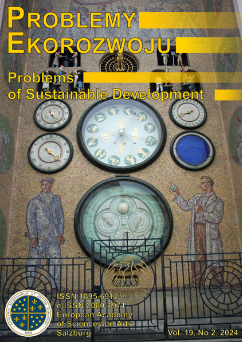Distance Difficult to Overcome? Analysis of Norwegian and Polish Position on the Path to Sustainable Development
Artur Zimny
State University of Applied Sciences in Konin, Faculty of Social Sciences and Humanities, Department of Managerial Studies and Logistics, ul. Przyjaźni 1, 62-510 Konin (Poland)
Karina Zawieja-Żurowska
State University of Applied Sciences in Konin, Faculty of Social Sciences and Humanities, Department of Political Studies and Internal Security, ul. Przyjaźni 1, 62-510 Konin (Poland)
Abstract
Sustainable development is undoubtedly the key challenge of the contemporary world. On the way to this development Poland if far behind the other countries, especially Norway, which seems to be an unquestionable leader in this respect in Europe. There is a distance between Norway and Poland in all ten dimensions (themes) described in the EU Sustainable Development Strategy (socio-economic development, sustainable consumption and production, social inclusion, demographic changes, public health, climate change and energy, sustainable transport, natural resources, global partnership and good governance). Unfortunately it is not likely that the distance could be significantly reduced in the coming years. Poland must accept that fact and simultaneously learn from the leader and take advantage of its experience, but can also benefit from financial support, which is possible to obtain from the EEA and Norway Grants – the funds provided to particular programs aimed at reducing economic and social disparities and strengthening bilateral relations between Norway and Poland.
Keywords:
sustainable development, development gap, Poland, NorwayReferences
CBOS, 2013, Poczucie wpływu na sprawy publiczne, Komunikat z badań CBOS nr BS/121/2013, Warszawa, p. 1.
Google Scholar
CBOS, 2014, Opinie o działalności parlamentu, prezydenta i Państwowej Komisji Wyborczej, Komunikat z badań CBOS nr 169/2014, Warszawa, p. 1.
Google Scholar
EUROPEAN COMMISSION, UE Budget in My Country, http://ec.europa.eu/budget/mycountry/PL (12.02.2015).
Google Scholar
EUROPEAN COMMISSION, 2005, The 2005 Review of the EU Sustainable Development Strategy: Initial Stocktaking and Future Orientation, COM(2005) 37 final, Brussels.
Google Scholar
EUROPEAN COMMISSION, 2007, Progress Report on the Sustainable Development Strategy 2007, COM(2007) 642 final, Brussels.
Google Scholar
EUROPEAN COMMISSION, 2009, Mainstreaming sustainable development into EU policies: 2009 Review of the European Union Strategy for Sustainable Development, COM(2009) 400 final, Brussels.
Google Scholar
EUROPEAN COMMISSION, 2010, Europe 2020. A European Strategy for smart, sustainable and inclusive growth, http://ec.europa.eu/eu2020/pdf/COMPLET%20EN%20BARROS0%20%20%20007%20-%20Europe% 202020%20-%20EN%20version.pdf (1.02.2015).
Google Scholar
EUROPEAN COUNCIL, 2001, A Sustainable Europe for a Better World: A European Union Strategy for Sustainable Development, COM(2001)264 final, Brussels.
Google Scholar
EUROPEAN COUNCIL, 2006, Renewed EU Sustainable Development Strategy, Brussels.
Google Scholar
EUROSTAT, Headline Indicators, http://ec.europa.eu/eurostat/web/sdi/indicators (6.02.2015).
Google Scholar
EUROSTAT, 2013, 2013 monitoring report of the EU sustainable development strategy, Luxembourg.
Google Scholar
EUROPEAN UNION, 2008, Consolidated Version of the Treaty on European Union, http://www.basiclaw.net/Appendices/eu_cons_treaty_en.pdf (1.03.2015).
Google Scholar
Fundusze norweskie i EOG na lata 2009-2014, http://www.eog.gov.pl (12.02.2015).
Google Scholar
GŁÓWNY URZĄD STATYSTYCZNY, Information Portal, http://stat.gov.pl (06.02.2015).
Google Scholar
GŁÓWNY URZĄD STATYSTYCZNY, URZĄD STATYSTYCZNY W KATOWICACH, 2011, Wskaźniki zrównoważonego rozwoju Polski, Katowice, p. 8.
Google Scholar
Konstytucja Rzeczypospolitej Polskiej z dnia 2 kwietnia 1997 r., 1997, Dz. U. z 1997 r. Nr 78 poz. 483 z późn. zm., art. 5.
Google Scholar
OECD, Statistics, http://stats.oecd.org/Index.aspx (06.02.2015).
Google Scholar
RYDZEWSKI P., 2015, Sustainable Development as Seen by the Residents of Eastern and Western Europe on the Basis of ISSP Environment Data, in: Problemy Ekorozwoju/ Problems of Sustainable Development, vol. 10, no 1, p. 49-53.
Google Scholar
Ustawa z dnia 27 kwietnia 2001 r. Prawo ochrony środowiska, 2001, Dz. U. z 2001 r. Nr 62 poz. 627 z późn. zm., art. 3 pkt 50.
Google Scholar
WCED, 1987, Our Common Future, Oxford University Press, New York.
Google Scholar
WORLD BANK, Indicators, http://data.worldbank.org/indicators (10.02.2015).
Google Scholar
Authors
Artur ZimnyState University of Applied Sciences in Konin, Faculty of Social Sciences and Humanities, Department of Managerial Studies and Logistics, ul. Przyjaźni 1, 62-510 Konin Poland
Authors
Karina Zawieja-ŻurowskaState University of Applied Sciences in Konin, Faculty of Social Sciences and Humanities, Department of Political Studies and Internal Security, ul. Przyjaźni 1, 62-510 Konin Poland
Statistics
Abstract views: 27PDF downloads: 8
License

This work is licensed under a Creative Commons Attribution-ShareAlike 4.0 International License.




